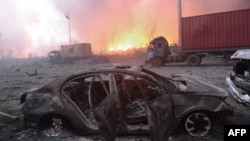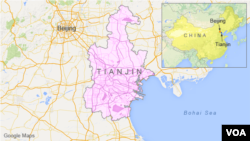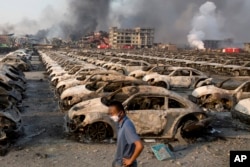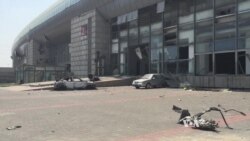Chinese authorities are continuing an investigation into what caused two gigantic explosions at a warehouse in a main port city, as locals expressed fears about the possible presence of dangerous chemicals near the site.
Several small fires were still smoldering early Friday at the site of the blasts, which occurred late Wednesday in a warehouse storing dangerous chemicals in a mostly industrial neighborhood in the northeastern city of Tianjin.
Officials say at least 50 people were killed and 700 others injured, with 70 in serious condition. It is not known how many people are missing, and there are widespread expectations that the death toll will continue to grow.
A team of 217 military nuclear and biochemical specialists, along with a group from the International Atomic Energy Agency's Beijing office, have been dispatched to the area, according to the official Xinhua news agency.
Tianjin safety authorities said Friday they have not determined what specific dangerous chemicals were stored in the warehouses.
Danger
The investigation has been hampered by the potentially dangerous situation on the ground, according to Nankai University School of Environmental Science professor Feng Yinchang.
"There's a lot about the situation on the ground that's not very clear - exactly what pollutants, what exploded, also what there is...we don't know," said Feng at a press conference with government officials. "If the situation is not clear, we can't clearly determine what kind of pollutants were emitted into the air."
Major discrepancies
Officials quoted by Xinhua said there are "major discrepancies between the accounts of company management and customs." Management officials of the company that operated the warehouse have already been brought into custody.
High densities of toxic gases, including sulfur dioxide, carbon monoxide and nitrogen oxides were detected within 500 meters of the fire, according to Tianjin's environmental office on Thursday. But it said toxic fumes within the city are "within national standards."
Tianjin municipal authorities have set up 22 monitoring stations, five of which are checking water quality, according to the China Daily. It said hazardous substances, including a highly toxic cyanide, were found three times and eight times higher than normal during a test of two drainage outlets near the blast site.
A report in the state-run Beijing News reported earlier that at least 700 tons of sodium cyanide were being held at the warehouse. The report, which was later removed, said the toxic chemical had been detected in sewage samples.
Public skepticism
Many locals were on edge Friday and public skepticism over the government's accounts was widespread, due in part to the Chinese government's well-documented record of playing down environmental and pollution hazards.
The first explosion took place just after 11:30 p.m. local time Wednesday, followed shortly by a second more powerful blast. China's National Earthquake Bureau said the first blast was the equivalent of 3 tons of TNT, and the second 21 tons.
Pictures and videos showed gigantic plumes of fire and a mushroom cloud that dwarfed nearby high-rise buildings and sent out a massive shockwave that rattled residents several kilometers from the blast site.
Tianjin is a port city in northeastern China, about 150 kilometers southeast of Beijing, and is home to more than 15 million people. It is China's fourth largest city.
International condolences
In the U.S., the White House sent its condolences; spokesman Ned Price called the explosions a tragedy and praised the first responders working to help the injured.
U.N. Secretary-General Ban Ki-moon in a statement extended his condolences to the families of the victims, including the fire fighters, who, he said, "made the ultimate sacrifice."
Chinese officials say over a dozen firefighters were killed in the explosion. Many more are believed to be missing.
WATCH: VOA's Bill Ide reports from the scene in Tianjin, China












